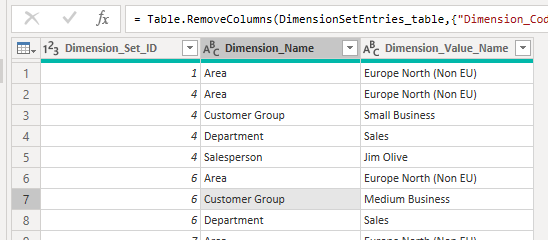I have used the web services connector to query the Dimensionsetentries.

Remove the columns not needed to leave dim set id, the dimension identifier and the dimension value identifier. I have retained The description columns rather than the code columns as I am thinking end user. Under different circumstances, I may keep the codes rather than descriptions

Select the column that contains your dimension code or name (not the value). Then select the transform menu and Pivot column. Choose the options shown below.
The value column is the dimension value code or name.

You now have a table of dimension set id as row identifiers, dimension names as columns and dimension values under each column.

You can remove null values with replace.
Worth noting that this approach shows all dimensions as columns regardless of what data we join the table too. If you only want relevant dimesnions to show, you'd be best off filtering them earlier in your data extraction so that only required ones appear.



